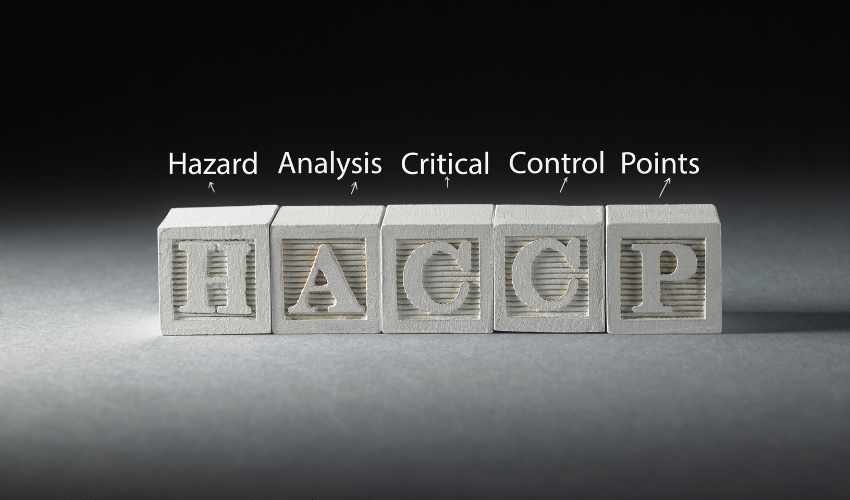
BLOG

What Is A Hazard Critical Control Point?
HACCP stands for Hazard Critical Control Point and is a systematic approach to food safety that identifies, evaluates, and controls potential hazards in the food production process. It is widely used in the food industry to ensure that products are safe for consumption. In this article, we’ll explore the basics of HACCP, its importance, the 7 principles of HACCP, the 12 steps of HACCP, and the benefits of obtaining HACCP certification. We will also cover how to get started with HACCP training and provide an example of a HACCP plan.
What Does HACCP Stand For?
HACCP stands for Hazard Critical Control Point and is a preventive food safety system that analyzes and manages physical, chemical, and biological hazards during food production. The goal is to identify potential risks and take proactive steps to eliminate or reduce these hazards, ensuring that the final product is safe for consumers.
The Importance of HACCP
The importance of HACCP in the food industry cannot be overstated. It helps businesses prevent foodborne illnesses, reduce risks of contamination, and comply with national and international food safety regulations. By implementing HACCP, companies can build trust with their customers, protect their brand reputation, and avoid costly recalls or legal issues related to food safety breaches.
The 7 Principles of Hazard Critical Control Point
The HACCP system is based on 7 principles that guide the implementation and management of food safety practices:
Conduct a Hazard Analysis
Identify potential Hazard Critical Control Point that could affect food safety in the production process, including physical, chemical, and biological risks. Assess the likelihood of these hazards occurring and determine their impact on consumer health.
Determine Hazard Critical Control Point (CCP):
Identify the specific points in the production process where hazards can be prevented, eliminated, or reduced to acceptable levels. These are known as Hazard Critical Control Point (CCP).
Establish Critical Limits:
Set measurable limits for each CCP that must be met to control the identified Hazard Critical Control Point. Critical limits can include temperature, time, pH levels, or other parameters.
Establish Monitoring Procedures:
Implement procedures to regularly monitor each CCP to ensure that critical limits are being met. Monitoring can involve visual inspections, measurements, or testing.
Establish Corrective Actions:
Develop corrective actions to take when a CCP does not meet the established critical limits. These actions should be designed to prevent unsafe products from reaching consumers.
Establish Verification Procedures:
Implement verification activities to confirm that the HACCP system is working effectively. This includes reviewing records, conducting tests, and performing audits.
Establish Record-Keeping and Documentation Procedures:
Maintain detailed records of all HACCP processes, including hazard analyses, monitoring data, corrective actions, and verification results. Documentation is crucial for demonstrating compliance with food safety standards.
The 12 Steps of HACCP
The implementation of a HACCP plan involves 12 steps that provide a structured approach to food safety management:
Assemble the HACCP Team:
Gather a multidisciplinary team with expertise in food production, safety, and quality control.
Describe the Product:
Provide a detailed description of the food product, including ingredients, processing methods, and shelf life.
Identify the Intended Use:
Determine how the product will be used by the consumer and whether there are specific handling instructions.
Construct a Flow Diagram:
Create a step-by-step flowchart of the food production process from raw materials to final product.
Verify the Flow Diagram:
Ensure that the flow diagram accurately represents the production process and includes all relevant steps.
Conduct a Hazard Analysis:
Identify potential Hazard Critical Control Point at each stage of the production process.
Determine Hazard Critical Control Points (CCPs):
Pinpoint the specific steps where hazards can be controlled.
Establish Critical Limits:
Set acceptable limits for each CCP.
Establish Monitoring Procedures:
Develop methods to monitor each CCP and ensure hazard critical control limits are met.
Establish Corrective Actions:
Plan corrective measures to take when a CCP fails to meet critical limits.
Establish Verification Procedures:
Verify the effectiveness of the HACCP plan.
Establish Record-Keeping Procedures:
Document all HACCP-related activities and decisions.
What Is HACCP Certification?
HACCP certification is a formal recognition that a food production facility has implemented a HACCP-based food safety management system. It indicates that the company has taken necessary steps to identify and control food safety hazards, reducing the risk of contamination. Certification is often required to meet regulatory standards and is valued by consumers as a mark of product safety and quality.
Benefits of HACCP Certification:
- Regulatory Compliance: Helps meet local, national, and international food safety regulations.
- Enhanced Product Safety: Reduces the risk of foodborne illnesses and contamination.
- Increased Market Access: Allows businesses to enter new markets that require certified food safety systems.
- Brand Reputation: Builds trust and credibility with customers by demonstrating a commitment to food safety.
HACCP Training: Essential for Food Safety
HACCP training is essential for food industry professionals who need to understand the principles and application of HACCP. Training provides the knowledge and skills required to effectively implement and manage a HACCP system. Various HACCP training online options are available, including courses that cover the 7 principles of HACCP, food safety regulations, and practical examples.
Key Topics Covered in HACCP Training:
- Overview of food safety hazards and risk management.
- Detailed explanation of the 7 HACCP principles.
- Techniques for identifying and managing Hazard Critical Control Point (CCP).
- Record-keeping and documentation procedures.
- Case studies and real-world HACCP plan examples.
HACCP Plan Example
A HACCP plan example provides a practical template that businesses can use to develop their own HACCP system. Below is a simple example of a HACCP plan for a food production facility:
- Product Description: Ready-to-eat sandwiches.
- Potential Hazards: Bacterial contamination, physical hazards from packaging.
- CCP Identification: Temperature control during storage and transport.
- Critical Limit: Store sandwiches at 4°C or below.
- Monitoring: Temperature checks every hour.
- Corrective Action: If the temperature exceeds 4°C, discard affected products.
- Verification: Regular audits and review of temperature logs.
- Record-Keeping: Maintain logs of temperature checks and corrective actions taken.
The Role of HACCP in Food Safety Management
HACCP plays a critical role in maintaining food safety by focusing on preventing hazards rather than reacting to them. It helps businesses identify potential risks in the production process and take proactive steps to control these risks before they become a problem.
Why HACCP Is Important?
- Prevents Foodborne Illnesses: Reduces the risk of food contamination that can lead to illness.
- Ensures Compliance: Meets food safety standards required by regulatory authorities.
- Reduces Recalls: Minimizes the chances of costly product recalls due to safety issues.
- Boosts Consumer Confidence: Shows a commitment to producing safe and high-quality food products.
Conclusion
Understanding what HACCP is and implementing a well-structured HACCP plan is essential for any business involved in food production and processing. By following the HACCP 7 principles and completing the 12 steps of HACCP, companies can create a robust food safety management system that meets industry standards and protects consumers. Investing in HACCP training and obtaining HACCP certification will not only help you comply with regulations but also enhance your brand’s reputation and open up new market opportunities.
Start your journey to food safety excellence by learning more about HACCP training online, exploring practical HACCP plan examples, and developing a comprehensive approach to hazard analysis and control in your facility.

Hazard Critical Control Point FAQs
What is HACCP and why is it important?
HACCP stands for Hazard Critical Control Point. It is a systematic approach to identifying, evaluating, and controlling food safety hazards in production. HACCP is important because it helps prevent contamination, ensures food safety, and protects consumers from foodborne illnesses by addressing potential risks before they become problems
What are the HACCP 7 principles?
The HACCP 7 principles include:
- Conduct a hazard analysis.
- Identify hazard critical control point (CCP).
- Establish critical limits.
- Monitor CCPs.
- Establish corrective actions.
- Verify the HACCP system’s effectiveness.
- Maintain proper record-keeping and documentation.
Do I need HACCP certification for my food business?
Yes, HACCP certification is often required for food businesses to meet regulatory requirements and industry standards. It demonstrates that your company follows strict food safety protocols, reducing the risk of foodborne illnesses and improving consumer confidence in your products
How can I get started with HACCP training?
You can get started with HACCP training by enrolling in online courses or in-person workshops that cover the fundamentals of HACCP, including its principles, hazard analysis techniques, and implementation strategies. Training is essential for food safety managers, production staff, and anyone involved in the development of a HACCP plan.
What is a HACCP plan, and can you give an example?
A HACCP plan is a structured document that outlines how a food business will control and monitor potential hazards in the production process. For example, a HACCP plan for a dairy facility might include steps like pasteurization as a hazard critical control point with a specific temperature requirement, regular temperature checks, and corrective actions in case the temperature falls outside the set limits.
How to get HACCP certification online?
To get HACCP certification online, follow these steps:
- Enroll in a recognized HACCP training course: Look for accredited online training programs that cover the principles of HACCP, food safety regulations, and implementation strategies.
- Complete the training modules: Most courses consist of multiple modules that you must complete, including hazard analysis, critical control points, and monitoring procedures.
- Pass the certification exam: After completing the training, you will need to pass an exam to demonstrate your understanding of HACCP principles and food safety management.
- Receive your certification: Once you pass the exam, you will receive a certificate that verifies your knowledge and skills in implementing HACCP systems. Some certifications may require periodic renewal or additional training.
How long does it take to get HACCP certification?
The time it takes to get HACCP certification varies depending on the training program and your level of experience. Typically, most online HACCP certification courses can be completed within a few days to a few weeks. If you are new to food safety systems, it might take longer as you may need to study and understand the HACCP principles in more detail. On average, it can take anywhere from 20 to 40 hours of study time to complete the course and pass the certification exam.
